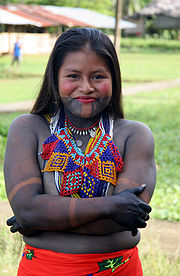
Emberá languages
Encyclopedia

Colombia
Colombia, officially the Republic of Colombia , is a unitary constitutional republic comprising thirty-two departments. The country is located in northwestern South America, bordered to the east by Venezuela and Brazil; to the south by Ecuador and Peru; to the north by the Caribbean Sea; to the...
and southeastern Panama
Panama
Panama , officially the Republic of Panama , is the southernmost country of Central America. Situated on the isthmus connecting North and South America, it is bordered by Costa Rica to the northwest, Colombia to the southeast, the Caribbean Sea to the north and the Pacific Ocean to the south. The...
. It belongs to the Choco
Choco languages
The Choco languages are a small family of Native American languages spread across Colombia and Panama.-Family division:Choco consists of perhaps ten languages, half of them extinct....
language family
Language family
A language family is a group of languages related through descent from a common ancestor, called the proto-language of that family. The term 'family' comes from the tree model of language origination in historical linguistics, which makes use of a metaphor comparing languages to people in a...
.
Embera, Emperã, Empena, Eberã, Epena, etc. is the Embera word for 'human being', and is used as the autonym by all speakers of varieties of Embera (though by the related Wounaan).
Languages and regional variation
Emberá is usually divided into at least two languages:- Northern Emberá
- Southern Emberá
Each has a few regional varieties
Variety (linguistics)
In sociolinguistics a variety, also called a lect, is a specific form of a language or language cluster. This may include languages, dialects, accents, registers, styles or other sociolinguistic variation, as well as the standard variety itself...
. These varieties are often considered dialect
Dialect
The term dialect is used in two distinct ways, even by linguists. One usage refers to a variety of a language that is a characteristic of a particular group of the language's speakers. The term is applied most often to regional speech patterns, but a dialect may also be defined by other factors,...
s, but are also identified as distinct language
Language
Language may refer either to the specifically human capacity for acquiring and using complex systems of communication, or to a specific instance of such a system of complex communication...
s. Archive of the Indigenous Languages of Latin America lists them as follows, along with alleged sub-varieties which may be places, extinct groups, or misspellings:
- Northern (Northern Antioquia, Emberá norteño)
- CatíoCatio-Embera languageCatío Emberá is an indigenous American language spoken by the Embera people of Colombia and Panama.The language was spoken by 15,000 people in Colombia, and a few dozen in Panama, according to data published in 1992. 90 to 95% of the speakers are monolingual with a 1% literacy rate...
(Katío): Dabeiba, Tukurá (Río Verde, upper Sinú, Emberá-Katío), Ngverá (San Jorge) - West EmberaNorthern Embera languageNorthern Emberá, also known as West Embera and Cholo, is the largest Embera language. It is spoken largely in Colombia, but is also the principal language of the Darien Gap in Panama....
(Citará, Northwest Embera, Northern Embera): Darién (Sambú, Panamá Embera), Citará (Atrato, Andágueda), Juradó - Southern
- Chamí (Caramanta, Embera-Chamí, East Embera, Southern Antioquia): Tadó*, Cristianía, Upper Andágueda, Mistrató, Garrapatas
- BaudóBaudo languageBaudó Emberá Baudó is an Embera language of Colombia. It is partially intelligible with both Northen Embera and Eperara, and it's not clear which branch of Embera it belongs to....
: Catrú, Dubasa, Purricha, Pavaja - Eperara (Epena): Joaquincito, Cajambre, Naya, Saija, Tapaje, Satinga
Ethnologue (2005, 2009) treats Tadó (*) as a separate language. A case can be made for classifying Baudó as a Northern Embera language. It has many features of both groups, and indeed is mutually intelligible with the neighboring Northern Embera dialect as well as with Epena.

